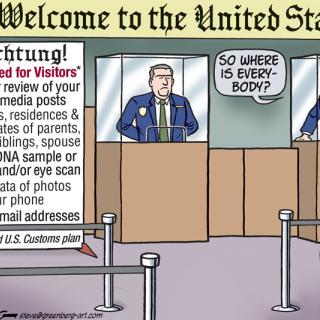Quietly, as usual, the undemocratic apparatuses of the City of Columbus make their moves.
On Friday, Dec. 10, the Columbus Dispatch briefly reported “Massive hanging sculpture proposed for Downtown.”
The next day, Dispatch reporter Jim Welker wrote, “City seeks input on reviving Downtown” (print edition). In this case, the City and the Columbus Downtown Development Corporation, a “nonprofit public development corporation,” a contradiction in terms, “are launching a series of [unscheduled] public meetings to help shape a new Downtown Strategic Plan.
With no definitions, structures, or timetables, and no metrics, we see once more an outburst of aspirational sloganeering, and neither professional nor citizen-driven urban planning. These efforts are led by unelected, unrepresentative “commissions” and “corporations” responsible to no one. [See Kevin Cox, Boomtown Columbus: Ohio’s Sunbelt City and How Developers Got Their Way (Ohio State University Press, 2021); Ellen Manovich, “‘Time and Change Will Surely Show’: Contested Urban Development in Ohio State’s University District,” Journal of Social History, 51 (2018), 1069-1099, two of the surprisingly few documented sources on Columbus.]
That fundamental fact is inseparable from these downtown boosters’ ignorance of urban history, including Columbus’, and the tenets of urbanism across disciplines. The city’s identity crisis is also a contributing factor. (See my “Columbus’ identity crisis and its media,” Columbus Underground, July 23, 2021.) Not surprisingly, Columbus has no tradition of urban planning and no expertise or experience in that government area.
Reading these slim news reports led me to contact the agencies. Given the disorganization and inscrutability of Columbus City Government, I consulted an excellent City Council legislative aide who has directed me on other occasions. On Dec. 10 I wrote to the Columbus Downtown Commission of the City of Columbus, and on Dec. 11 I contacted the Columbus Downtown Development Corporation. I was surprised to discover that this odd, purportedly public body devoted to advancing private development is chaired by retired mayor Michael Coleman. (See my “Busting Myths: Columbus city government is undemocratic and disorganized: It’s 2021 and we need a revolution.”)
To Columbus Downtown Commission, I stated the following [comments apart from my statement to them are in brackets]:
I write as a home-owning, taxpaying citizen of the City of Columbus and an internationally known expert on cities. I condemn in the strongest terms the Edwards Companies’ ridiculous proposal to deface down Columbus with an unaesthetic, inappropriate, and environmentally harmful pseudo-sculpture. [The private real estate apartment developer Edwards Companies proposes a blue and read fabric “sculpture”—“a cloud-like abstraction”—to stretch about 180 feet, 60 feet high, 50 feet wide above Gay Street, “straddling” High Street.in Downtown.]
Not only is it not a sculpture but a banner, it has no place in the downtown of a large city. It has no aesthetic qualities or relevance to the physical site. [How can a two-color banner promote a downtown “art hub” other than rhetorically? Have these developers ever seen an urban “art hub”?]
It is a hazard to birds and also to drones whose arrival for deliveries will come soon enough.
It is yet another self-promotional act of a developer (who profits from OSU’s financial-loss-leader and mismanaged Campus Partners) who damaged High Street in the University District by overbuilding unaesthetic student apartment buildings (with false, promotional names like “The View on High,” which has no view!) and overwhelms traffic congestion in that area.
The Downtown Commission must respond responsibly with basic regard for urbanism, civility, safety, and democratic oversight.
I ask that my views—which I am pleased to amplify, but not unsafely in person—be entered into the record.
On Dec. 11 I wrote the following to the Columbus Downtown Development Corporation (a private nonprofit development corporation) [comments in brackets]:
I am alarmed by reports in the Columbus Dispatch (Dec. 11, 2021) that the CDDC us “seeking input on reviving Downtown.” “Reviving” as a legitimate concept or planning term directly implies a return to a former or pre-existing status. But there is no such state in Columbus history. [Or, do they only mean a return to pre-pandemic occupancy levels, as mentioned in the newspaper report? That’s not what “urban revival” signifies.]
Moreover, “a nonprofit public development corporation” is itself a contradiction in terms. Can you explain this to a home-owning, taxpaying citizen who is also an internationally recognized expert on cities?
No, I do not expect a response.
These are not isolated instances. Both the state of Downtown and the absence of an urban design or planning ethic or estate in the city demonstrate this lack. Neither boosters nor self-described “planners” and developers pay attention to either city history (thus no “revivals”) or the elements of the urban landscape itself. This includes nearby structures. These thin proposals contradict both their own efforts and the betterment of urban life for all Columbus residents.
Thus recent, often inexplicable notions include the wild idea of the July 2021 “Rapid 5” cloudy “vision for connecting all of Franklin County, via parks and [especially] waterways.” This muck of metaphors envisions “kayaking to work” and “hiking from the suburbs to Downtown for dinner,” among other whimsies. The so-called “Rapid 5 Project” initiative proposes—without plan, budget, or timeline—“improved links between greenways and area waterways.”
While neglecting the ownership of the requisite properties, the planners also ignore the physical geography of Columbus and Franklin County. Their “vision”—metaphorical or metaphysical—imagines Columbus as a “new” Amsterdam. Among the innumerable complications is their unfamiliarity with the real Amsterdam. Circular canals span that historic city, not trenches dug to connect the streams and ponds of Metro Parks.
A final set of examples, less fanciful and fictional than “Rapid 5,” are proposals for skyscrapers of 30 or more stories towering over the much-lower heights of buildings in the North Market area on one edge of Downtown, and the Scioto Peninsula on the other side. Questions of funding and approvals aside, I ask again if the boosters, developers, or planners have ever examined the sites closely and the human interactions that take place within them?
I end by offering a modern primer for urbanists and planners, even developers, a blend of the classics and more recent significant works. This is a short course. I see no evidence that our current self-appointed city-makers and -shakers are familiar with them or with the cities they wish to imitate if not emulate.
Begin with Kevin Lynch, The Image of the City (MIT Press, 1960);Edward Krupat, People in Cities: The Urban Environment and Its Effects (Cambridge University Press, 1985); Mike Davis, City of Quartz: Excavating the Future in Los Angeles (Verso Books, 1990); Sharon Zukin, Landscapes of Power: From Detroit to Disney World (University of California Press, 1991); and Michael Pagano and Ann O’M. Bowman, Cityscapes and Capital: The Politics of Urban Development (Johns Hopkins University Press, 1995).
Then turn to Margaret Pugh O’Mara, Cities of Knowledge: Cold War Science and the Search for the Next Silicon Valley (Princeton University Press, 2005);Michele N. Bogart, The Politics of Urban Beauty: New York and its Arts Commission (University of Chicago Press, 2006); Mike Davis and Daniel Bertrand Monk, eds., Evil Paradises: Dreamworlds of Neoliberalism (New Press, 2007); and Harvey J. Graff, The Dallas Myth: The Making and Unmaking of an American City (University of Minnesota Press, 2008).
Finally, read Cox, Boomtown Columbus and Manovich, “‘Time and Change Will Surely Show,’” cited above.
Only then, reexamine Columbus, Ohio, with educated, informed eyes.
--------------------------------
Harvey J. Graff is Professor Emeritus of English and History and Ohio Eminent Scholar at The Ohio State University. He is the author of many books on social history including The Literacy Mythand The Dallas Myth. His specialties include the history and present condition of literacy and education including higher education, children and families, cities, interdisciplinarity, and contemporary politics, culture, and society.



